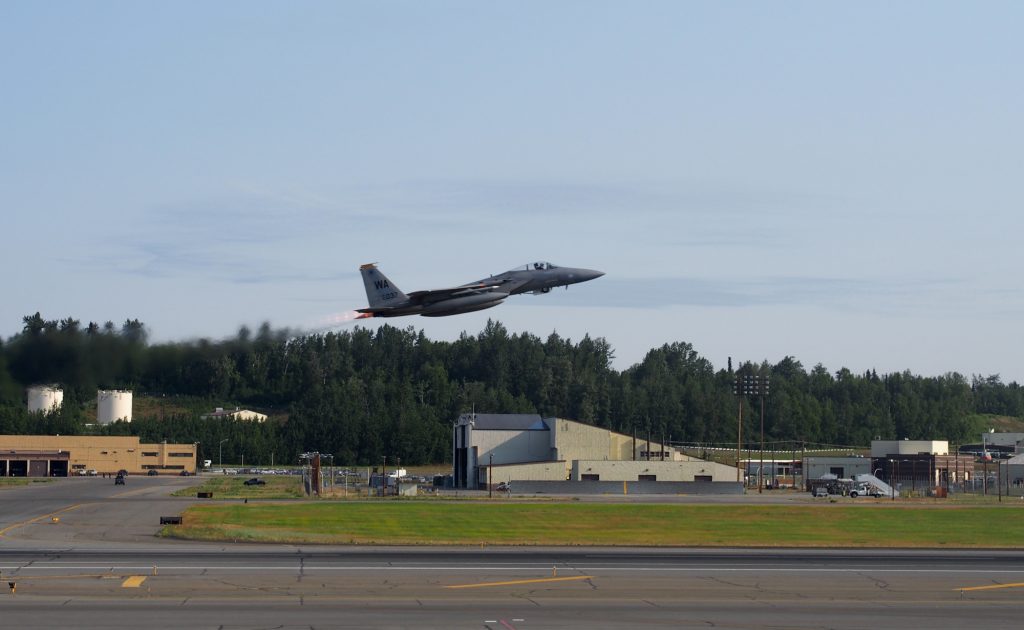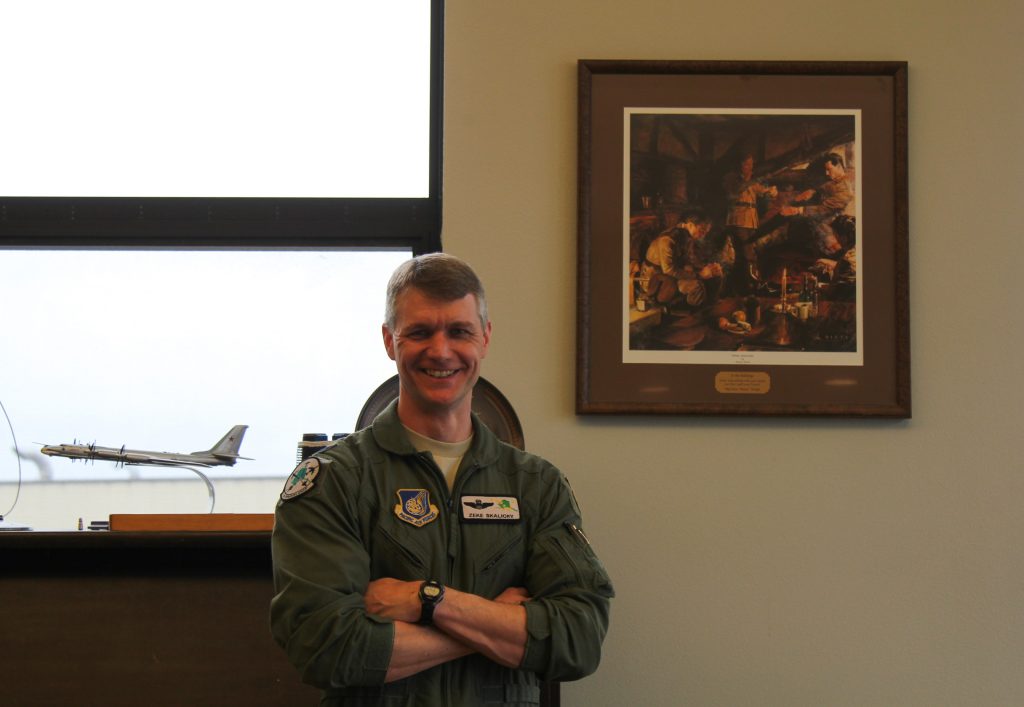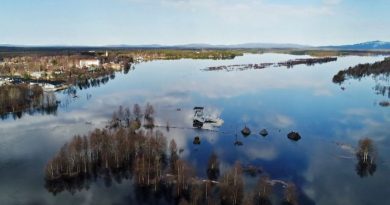Why are elite fighter pilots leaving the U.S. Air Force?

The Air Force has a multi-billion dollar problem with one of its most expensive assets: pilots.
Across all of its branches, the American military is having trouble filling its ranks. For the Air Force, the main issue is retaining pilots after they’ve gone through years of costly training. And those staffing problems are only likely to get worse in the years ahead.
At Joint Base Elmendorf-Richardson in Anchorage, the 90th Fighter Squadron has a heritage room — basically a club house — decorated with memorabilia, beer steins and a large, well-worn popcorn machine.
“In every single fighter squadron across the Air Force you will find a popcorn machine that produces jalapeno popcorn,” Lieutenant Colonel Dave Skalicky, who commands the squadron, explained. Skalicky is tall, clean cut and talks in excitable bursts tinged with faint remnants of his Minnesotan roots.
At Air Force bases around the world, elite flyers have a ritualistic affinity for the snack. Junior officers are tasked with frying the jalapenos, sprinkling salt and popping the corn, as well as brewing coffee, ahead of early morning mission briefs.
In addition to his command responsibilities, Skalicky still flies an F-22 Raptor several times a week. The planes are one of the most agile, powerful jet fighters in the world. And Alaska is a choice assignment for getting to fly them. F-22s are regularly scrambled to intercept Russian long-range bombers that approach the U.S. And the wide open training ranges mean pilots have free reign to push the cutting-edge machines to their limits.
“It’s like getting tossed the keys to an Indy car,” Skalicky said of his first time flying a Raptor.

Hundreds of unfilled positions
Simply becoming an Air Force pilot is competitive. But flying jet fighters is a whole other echelon, one which qualified officers reach only by surviving years of academic work and batteries of tests.
Which is why it’s surprising that, even in Alaska, the Air Force is coping with a staffing shortage so severe that one general labeled it the “national aircrew crisis.”
In FY 2016, “the total force was short 1,211 fighter pilots,” Lieutenant General Gina Grosso told a House Armed Services subcommittee last year.
That figure fit within a broader deficit of 1,555 pilot positions across all the Air Force’s mission sets. Bomber and cargo plane pilots are also in short supply. But the problem is more acute with jet fighters.
According to a report this April from the Government Accountability Office, for more than a decade the gap between the number of pilots authorized and the number actually serving has widened. The GAO found that currently 27 percent of fighter pilot positions are unfilled.
This is not just a liability for military readiness and national security, Grosso explained. It’s also an extremely expensive problem. Training one pilot for his or her first assignment in an advanced plane like the F-22 takes $11 million. The upper-end estimate is that current pilot shortage amounts to a capital loss of $12 billion.
“Make no mistake, your Air Force is always there,” Grosso told lawmakers. “However, being always there comes at a cost to equipment, infrastructure, and most importantly our airmen.”
Pilots yearn to fly
So why are all these young, highly trained, elite pilots leaving?
One of the main reasons is that commercial companies are hiring them away. Globally, more planes are in the air, with growth in passenger air travel and cargo shipping prompting an accelerating demand for qualified pilots. Air Force pilots are attractive because they have typically met or exceeded the number of in-flight hours required by regulations. And a wave of older pilots are leaving the workforce as they turn 65, hitting the Federal Aviation Administration’s mandatory retirement age. Amid this boom, the salaries in the commercial sector are significantly higher than in the military.
But that’s just a piece of what’s going on.
“It’s not about the money,” David Gould said. Gould retired as a colonel after 26 years in the Air Force, much of it spent flying C-130 cargo planes. Now he works for United Airlines. The pay bump is nice, but Gould says the main reason that pilots leave is tied to the same reason they join in the first place: they want to fly as much as they can.
“I would guarantee it on my life: if you just had them do it enough, nobody would get out,” Gould said.
The problem, according to Gould, is Air Force pilots are in the cockpit less and less. Instead, they’re spending more time in training sessions and handling administrative duties.
“After a while you kind of look back and go, ‘I’m a pilot and I’m flying, if I’m lucky, once a week. What am I doing the other 80 percent of my time?’” Gould paused, before answering, “Stupid paperwork.”
Military life a strain on families
This isn’t just one retiree’s griping about the bygone days. The recent GAO report found the same thing. It also cited the Air Force lifestyle as one of the main reasons pilots opted not to re-enlist. Career-minded flyers face prolonged deployments, long work days and frequent moves that all put tremendous strain on family life.
Once they’ve met their service requirements, Gould says many younger pilots look around and decide the chance to keep flying cool aircraft isn’t worth the headache and personal sacrifice.
At the squadron-level, commanders like Skalicky try to tap in to pilots’ enthusiasm for the work itself.
“There is so much energy and so much drive in these people, in this professional corps of airmen that we have, that harnessing that energy, focusing it to get this mission done is more of a privilege than a challenge,” Skalicky said.
Air Force leadership is keenly aware of the pilot problem. They convinced Congress to increase the maximum allowable bonus pay given to pilots who re-enlist mid-way through their careers to $35,000 a year. According to Air Force spokesperson Erika Yepsen, the organization is also currently testing different personnel programs, such as halving some deployments. There is an additional experiment allowing some fighter pilots stay at stateside bases for an extra three hitch to spare them and their families moves. And the Air Force has hired contractors to take on some of the administrative work that had been saddling pilots.
Related stories from around the North:
Canada: Do Russian bomber patrols in the Arctic threaten Canada’s security and sovereignty?, Radio Canada International
Denmark: Denmark’s new defence agreement renews focus on protecting the Baltic, Radio Canada International
Finland: As Finnish Air Force seeks new fighters, expert weighs options, Yle News
Norway: How vulnerable is Norway to hybrid warfare?, The Independent Barents Observer
Russia: Simulated attack on Northern Norway targets by Russian bombers revealed, The Independent Barents Observer
Sweden: Should Gov be able to call on Finns if Sweden attacked?, Radio Sweden
United States: Safer airspace but more noise? U.S. Air Force considers changing jet flight patterns in Alaska, Alaska Dispatch News



